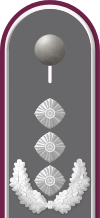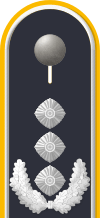Oberst
Oberst (German pronunciation: [ˈʔoːbɐst]) is a military rank in several German-speaking and Scandinavian countries, equivalent to Colonel. It is currently used by both the ground and air forces of Austria, Germany, Switzerland, Denmark, and Norway. The Swedish rank överste is a direct translation, as are the Finnish rank eversti and the Icelandic rank ofursti. In the Netherlands the rank overste is used as a synonym for a lieutenant colonel.
| Oberst | |
|---|---|
  | |
| Country | |
| Service branch | |
| Rank | Commissioned officer |
| NATO rank | OF-5 |
| Non-NATO rank | O-6 |
| Formation | 1956 |
| Next higher rank | Brigadegeneral |
| Next lower rank | Oberstleutnant |
| Equivalent ranks | Kapitän zur See |
Germany
Oberst (short: O) is the highest staff officer rank in the German Army (Heer) and the German Air Force (Luftwaffe).
- See also
⇒ Article: Ranks of the German Bundeswehr ⇒ Article: Rank insignia of the German Bundeswehr
Rank
The rank is rated OF-5 in NATO, and is grade A16 or B3 in the pay rules of the Federal Ministry of Defence. It is comparable in NATO to OF-5 and equivalent to:
- Oberstarzt, Oberstapotheker, and Oberstveterinär in the Joint Medical Service of the German Bundeswehr;
- Kapitän zur See and Flottenarzt in the German Navy.
On the shoulder straps (Heer, Luftwaffe) there are three silver pips (stars) in silver oak leaves.
| Heer | Luftwaffe |
|---|---|
|
|
- Bundeswehr sequence of ranks ascending
| junior rank: Oberstleutnant |
(German officer rank) |
senior rank: Brigadegeneral |
History
Oberst is a German word. Spelled with a capital O, "Oberst" is a noun and defines the military rank of colonel or group captain. Spelled with a lower case o, or "oberst", it is an adjective, meaning "top, topmost, uppermost, highest, chief, head, first, principal, or supreme". Both usages derive from the superlative of ober(e), "the upper" or "the uppermost".
As a family name, Oberst is common in the southwest of Germany, in the area known as the Black Forest (Schwarzwald). The name is also concentrated in the north-central cantons of Switzerland (Aargau & Zürich). Here the Swiss version of Oberst is spelled Obrist. The name first appeared in the thirteenth century in the German-Swiss border area, and early forms were Zoberist and Oberist. The name most likely refers to the "tribe that lives the highest on the mountain" or "the family that lives the highest in the village".
Translated as "superior" or "supreme", the rank of Oberst can trace its origins to the Middle Ages where the term most likely described the senior knight on a battlefield or the senior captain in a regiment. With the emergence of professional armies in the sixteenth and seventeenth centuries, an Oberst became the commander of regiment or battalion-sized formations.
By the eighteenth century, Obersten were typically afforded aides or lieutenants, often titled Oberstleutnant. This led to formation of the modern German rank of the same name, translated as lieutenant colonel. The rank of Oberst is equivalent to that of colonel in English-speaking armies, although its more accurate meaning of "supreme" refers to the fact that Oberst is the highest-ranking officer below general officers.
Oberst in East Germany
Oberst (en: colonel) was in the so-called armed organs of the GDR (German: Bewaffnete Organe der DDR), represented by Ministry of National Defence, and Ministry for State Security, the highest field officer rank, comparable to the colonel in many NATO-Armed forces (Rangcode OF-5). This was in reference to Soviet military doctrine and in line with other armed forces of the Warsaw Pact.
The equivalent rank of the Volksmarine (en: GDR Navy) was the Kapitän zur See, often called simply Genosse Kapitän for short.
| junior rank Oberstleutnant |
National People's Army rank Oberst (Kapitän zur See) |
senior rank Generalmajor |
| Rank insignias Oberst / Kapitän zur See (OF-5) | |||||||||
|---|---|---|---|---|---|---|---|---|---|
 |
 |
 |
 |
 |
 | ||||
| Oberst | Kapitän zur See | ||||||||
Oberst of the Wehrmacht
Oberst (English: Colonel) was in the German Reich, and Nazi Germany the highest field officer rank, comparable to the OF-5 rank in many NATO-Armed forces. It was equivalent to Kapitän zur See in the Kriegsmarine, and SS-Standartenführer in the Waffen-SS until 1945.
- Rank insignia Oberst, Kapitän zur See, and SS-Standartenführer
| Branch | German Army |
Luftwaffe |
Waffen-SS |
Kriegsmarine |
|---|---|---|---|---|
| Collar |  |
 |
None | |
| Shoulder | ||||
| Sleeve |  |
 |
 |
 |
| Rank designation |
Oberst |
Standartenführer der Waffen-SS |
Kapitän zur See | |
- Sequence of ranks ascenting
| junior rank: Oberstleutnant |
(German officer rank) |
senior rank: Generalmajor |
Popular culture
The rank of Oberst is known in American cinema, since several popular movies (such as The Great Escape, Stalag 17, The Eagle Has Landed, Hart's War, Raiders of the Lost Ark, and Live Free or Die Hard) have featured characters holding the rank. Luftwaffe Colonel Klink of the television series Hogan's Heroes was a caricature of such a character.




